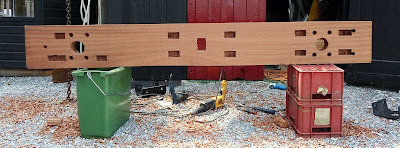Click any image to enlarge


Today we removed the rotten solebar or side member of the chassis. This was a point-of-no-return. It left the wheels unsupported on that side - picture 1.
When the heavy solebar crashed to the ground it broke in two - second picture.
This graphically illustrated the need to replace the entire solebar.
After a day's jolly hard work by me and Ged - assisted at one stage by John from the trolley staff - we had the new solebar in place and the chassis safe and sound again.
Thanks to Ged's amazing joinery skills everything has fitted to perfection.
Thinking of how the wagon was such a short time ago this is astonishing progress.



Today we removed the rotten solebar or side member of the chassis. This was a point-of-no-return. It left the wheels unsupported on that side - picture 1.
When the heavy solebar crashed to the ground it broke in two - second picture.
This graphically illustrated the need to replace the entire solebar.
After a day's jolly hard work by me and Ged - assisted at one stage by John from the trolley staff - we had the new solebar in place and the chassis safe and sound again.
Thanks to Ged's amazing joinery skills everything has fitted to perfection.
Thinking of how the wagon was such a short time ago this is astonishing progress.


























